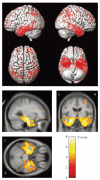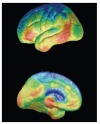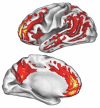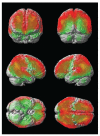Multimodal Imaging of Alzheimer Pathophysiology in the Brain's Default Mode Network
- PMID: 21629709
- PMCID: PMC3100676
- DOI: 10.4061/2011/687945
Multimodal Imaging of Alzheimer Pathophysiology in the Brain's Default Mode Network
Abstract
The spatial correlations between the brain's default mode network (DMN) and the brain regions known to develop pathophysiology in Alzheimer's disease (AD) have recently attracted much attention. In this paper, we compare results of different functional and structural imaging modalities, including MRI and PET, and highlight different patterns of anomalies observed within the DMN. Multitracer PET imaging in subjects with and without dementia has demonstrated that [C-11]PIB- and [F-18]FDDNP-binding patterns in patients with AD overlap within nodes of the brain's default network including the prefrontal, lateral parietal, lateral temporal, and posterior cingulate cortices, with the exception of the medial temporal cortex (especially, the hippocampus) where significant discrepancy between increased [F-18]FDDNP binding and negligible [C-11]PIB-binding was observed. [F-18]FDDNP binding in the medial temporal cortex-a key constituent of the DMN-coincides with both the presence of amyloid and tau pathology, and also with cortical areas with maximal atrophy as demonstrated by T1-weighted MR imaging of AD patients.
Figures






References
-
- Gusnard DA, Raichle ME. Searching for a baseline: functional imaging and the resting human brain. Nature Reviews Neuroscience. 2001;2(10):685–694. - PubMed
-
- Buckner RL, Andrews-Hanna JR, Schacter DL. The brain’s default network: anatomy, function, and relevance to disease. Annals of the New York Academy of Sciences. 2008;1124:1–38. - PubMed
-
- Wermke M, Sorg C, Wohlschläger AM, Drzezga A. A new integrative model of cerebral activation, deactivation and default mode function in Alzheimer’s disease. European Journal of Nuclear Medicine and Molecular Imaging. 2008;35(1):S12–S24. - PubMed

